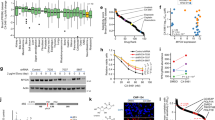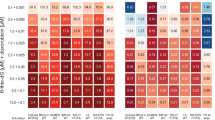Abstract
The anti-tumour activity of CPT-11, a topoisomerase I inhibitor, was evaluated in four human neural-crest-derived paediatric tumour xenografts; one peripheral primitive neuroectodermal tumour (pPNET) (SK-N-MC) and three neuroblastomas. Two models, SK-N-MC and IGR-N835, were established in athymic mice from a previously established in vitro cell line. Two new neuroblastoma xenograft models, IGR-NB3 and IGR-NB8, were derived from previously untreated non-metastatic neuroblastomas. They exhibited the classic histological features of immature neuroblastoma along with N-myc amplification, paradiploidy, chromosome 1p deletions and overexpression of the human mdr 1 gene. These tumour markers have been shown to be poor prognostic factors in children treated for neuroblastoma. CPT-11 was tested against advanced stage subcutaneous tumours. CPT-11 was administered i.v. using an intermittent (q4d x 3) and a daily x 5 schedule. The optimal dosage and schedule was 40 mg kg-1 daily for 5 days. At this highest non-toxic dose, CPT-11 induced 100% tumour-free survivors on day 121 in mice bearing the pPNET SK-N-MC xenograft. For the three neuroblastoma xenografts, 38-100% complete tumour regressions were observed with a tumour growth delay from 38 to 42 days, and anti-tumour activity was clearly sustained at a lower dosage (27 mg kg-1 day-1). The efficacy of five anti-cancer drugs commonly used in paediatric oncology or in clinical development was evaluated against SK-N-MC and IGR-N835. The sensitivity of these two xenografts to cyclophosphamide, thiotepa and cisplatin was of the same order of magnitude as that of CPT-11, but they were refractory to etoposide and taxol. In conclusion, CPT-11 demonstrated significant activity against pPNET and neuroblastoma xenografts. Further clinical development of CPT-11 in paediatric oncology is warranted.
Similar content being viewed by others
Author information
Authors and Affiliations
Rights and permissions
About this article
Cite this article
Vassal, G., Terrier-Lacombe, M., Bissery, M. et al. Therapeutic activity of CPT-11, a DNA-topoisomerase I inhibitor, against peripheral primitive neuroectodermal tumour and neuroblastoma xenografts. Br J Cancer 74, 537–545 (1996). https://doi.org/10.1038/bjc.1996.398
Issue Date:
DOI: https://doi.org/10.1038/bjc.1996.398
- Springer Nature Limited
This article is cited by
-
Antitumor effect of polyphyllin D on liver metastases of neuroblastoma
Pediatric Surgery International (2022)
-
Heterogeneity of neuroblastoma cell identity defined by transcriptional circuitries
Nature Genetics (2017)
-
Fifteen years of irinotecan therapy for pediatric sarcoma: where to next?
Clinical Sarcoma Research (2015)
-
Protracted dosing of the lipophilic camptothecin analogue AR-67 in non-small cell lung cancer xenografts and humans
Cancer Chemotherapy and Pharmacology (2014)
-
Synergistic interactions between camptothecin and EGFR or RAC1 inhibitors and between imatinib and Notch signaling or RAC1 inhibitors in glioblastoma cell lines
Cancer Chemotherapy and Pharmacology (2013)




